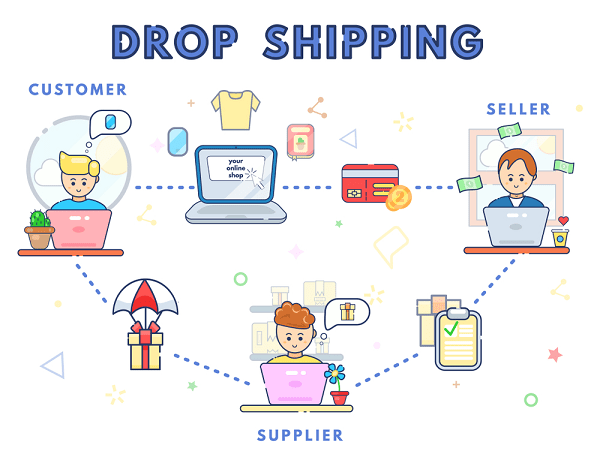Comparative of Dropshipping vs Affiliate Marketing
Dropshipping and Affiliate Marketing are two popular e-commerce business models that offer the potential for significant profits. Both methods allow individuals to sell products without having to physically handle or store inventory, making them appealing to those who want to start an online business with minimal investment and risk. However, while Dropshipping and Affiliate Marketing have similarities, they also have significant differences. Understanding these differences is critical to choosing the suitable business model for your needs. In this article, we will compare Dropshipping and Affiliate Marketing, highlighting the advantages and disadvantages of each method and helping you determine which model best fits your goals and abilities.
Overview
- Dropshipping: Dropshipping is a method of order fulfillment in which the business does not maintain an inventory of the products it sells. The process involves the seller sourcing the products from a third-party supplier, such as a wholesaler or manufacturer, only as they are needed to fulfill customer orders. This differs significantly from the traditional retail model, as the selling merchant acts as an intermediary rather than owning and storing their own inventory.
- Affiliate Marketing: Affiliate Marketing is a performance-based marketing model where publishers promote products or services other retailers or advertisers offer through affiliate links. These links enable the publisher to earn a commission when a specific action, such as a sale, is generated due to their promotional efforts.
In some cases, the desired outcome may include a lead, the initiation of a free trial, a website click, or even the download of an app. Affiliate marketing programs are typically accessible at no cost, making them a cost-effective option for individuals looking to start an online business. When executed effectively, an affiliate marketing strategy has the potential to generate a substantial income and grow from a side hustle into a profitable online venture.
How does it work?
- Dropshipping: The Dropshipping model involves a collaboration between a customer-facing store and a supplier. There are two commonly adopted approaches to implementing this business model. The first approach involves searching for one or more wholesale suppliers, either locally or globally, through the use of a supplier database. Alternatively, an individual may opt to use an app that provides access to a large network of suppliers, eliminating the need to independently search for suppliers for each product to be sold.

- Affiliate Marketing: Affiliate Marketing entails promoting a product or service through a blog, social media, podcast, or website, and earning a commission for every successful transaction made through the unique affiliate link associated with the promotion. Commission rates for affiliate sales can vary greatly among companies and offers, with some programs offering as low as 5% commission and others offering up to 50% commission, particularly for the promotion of classes or events. Some affiliate marketing programs also offer a fixed payout per sale rather than a commission based on a percentage of the sale.

Benefits And Drawbacks
Benefits of Dropshipping:
- Less upfront capital required: The Dropshipping model is accessible due to its low start-up cost, as it enables the launch of an online store without the need for large investments in inventory. With Dropshipping, the seller only purchases products after making a sale and receiving payment, reducing financial risk and saving costs.
- Easy to start: Dropshipping streamlines e-commerce by eliminating warehouse costs and order packing/shipping responsibilities, freeing up time and resources for other aspects of the business.
- Low overhead: Dropshipping reduces overhead expenses by eliminating the need for inventory purchase and fulfillment center management. Despite potential increases, costs remain low compared to traditional brick-and-mortar businesses, making it a cost-effective e-commerce solution.
- Flexible location: Dropshipping allows for flexible business operation from any location with internet access, as long as effective communication with suppliers and prompt customer service and support are maintained
- Wide selection of products to sell: Dropshipping allows you to offer a variety of popular products to your customers without the risk of unsold inventory, as you only purchase items after a sale has been made.
Drawbacks of Dropshipping:
- Low-profit margins: Low-profit margins are a major issue in highly competitive dropshipping as many businesses enter the market and sell products at low prices to increase revenue. This leads to high competition and thin margins. However, offering better website quality and customer service can help differentiate your business from others.
- Inventory issues: Staying on top of product inventory can be challenging when dropshipping from multiple warehouses. However, there are now tools that allow for syncing with suppliers, allowing for easy and efficient order fulfillment with real-time updates on inventory levels.
- Shipping complexities: Working with multiple suppliers in a dropshipping model means that the supply chain is beyond your control. This can result in multiple shipping charges for fulfilling an order from multiple suppliers, which may not be feasible to pass on to the customer. Managing these drop shipment calculations can also be challenging.
- Supplier errors: In the context of dropshipping, it is common for the seller to be held responsible for mistakes made by suppliers, even if they are not at fault. This can include issues with missing items, incorrect shipments, or product quality problems, all of which can harm the seller’s reputation.
- Limited customization and branding: In a dropshipping model, the seller has limited control over the product being sold as it is typically designed and branded by the supplier. While some suppliers may be flexible with product changes, the supplier ultimately has the most control, and any significant changes may require a minimum order quantity.
Benefits of Affiliate Marketing:
- Easy to execute: Your role is limited to handling digital marketing for product creation and sales. No need to worry about challenging tasks such as development, support, or delivery.
- Low risk: Joining affiliate programs is free, allowing you to earn money with established products/services without upfront investment. Affiliate marketing offers passive income through commissions. Initially, effort must be invested in creating traffic but affiliate links provide consistent earnings.
- Easy to scale: Effective affiliate marketing allows for earnings growth without additional personnel. You can introduce new products to your audience and create campaigns while existing work generates affiliate revenue. Keep in mind that trust is crucial in affiliate marketing.
Drawbacks of Affiliate Marketing:
- Requires patience: Affiliate marketing success takes time and patience. Test various channels to determine the best connection with your audience. Choose relevant and credible products to promote. Invest time in blogging, free content creation, virtual events, and other lead-generating efforts.
- Commission-based: As an affiliate marketer, you don’t receive a regular paycheck. You earn commissions from leads, clicks, or sales.
- No control over the program: As an affiliate, you must follow the rules set by the company for their program. Adhere to their guidelines for promoting their product or service. Competitors must follow the same guidelines, so you need to be creative to stand out from the crowd.
Similarities
Dropshipping and affiliate marketing share numerous similarities:
- Offer the opportunity to launch a business without stock or shipping management.
- Present low-risk business models.
- Have the potential for high earnings.
- Can be initiated quickly.
- Necessitate comparable skill sets, such as ad creation, traffic generation, and marketing proficiency.
- Entail low initial investment costs.
Conclusion
Both dropshipping and affiliate marketing are low-risk business models with low startup costs. They offer the opportunity to launch a business without the need for inventory or shipping management. While there are differences between the two, they also share similar skill sets and marketing strategies. Ultimately, the choice between dropshipping and affiliate marketing will depend on personal preferences, skills, and goals. Both models have the potential for success, and it’s up to the individual to determine which one is the best fit for them.








